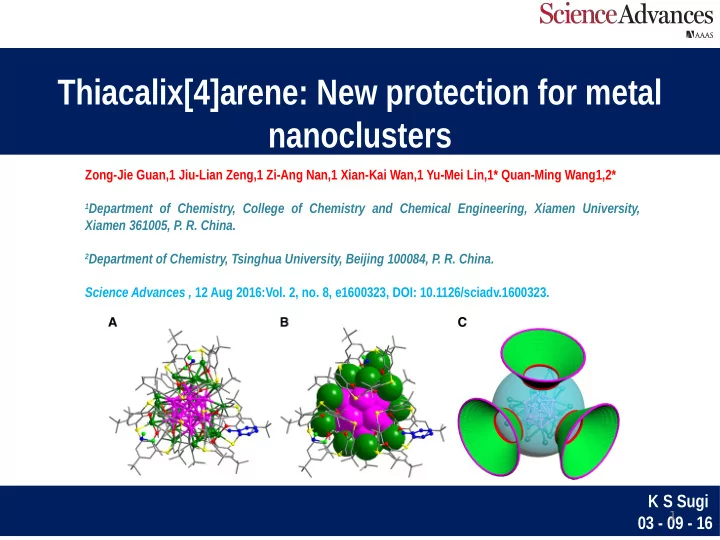

Thiacalix[4]arene: New protection for metal nanoclusters Zong-Jie Guan,1 Jiu-Lian Zeng,1 Zi-Ang Nan,1 Xian-Kai Wan,1 Yu-Mei Lin,1* Quan-Ming Wang1,2* 1 Department of Chemistry, College of Chemistry and Chemical Engineering, Xiamen University, Xiamen 361005, P. R. China. 2 Department of Chemistry, Tsinghua University, Beijing 100084, P. R. China. Science Advances , 12 Aug 2016:Vol. 2, no. 8, e1600323, DOI: 10.1126/sciadv.1600323. K S Sugi 1 03 - 09 - 16
Calixarene: Calixarene is a macrocycle or cyclic oligomer formed via a phenol - formaldehyde condensation. They exist in a ‘cup’ like shape with a defined upper and lower rim and a central annulus. Their rigid conformation enables calixarenes to act as host molecules as a result of their preformed cavities. By functionally modifying either the upper and/or lower rims it is possible to prepare various derivatives with differing selectivities for various guest ions and small molecules. Calixarenes are good candidates for binding metal ions because of their preorganized multidentate coordination sites. 2
Introduction: Bulky calixarene provides a rigid shell that protects a metal core, which may increase the stability of nanoclusters. In addition to the protection of nanoparticles, calixarenes are also promising surface capping ligands for new functional nanoclusters. Calixarene with macrocyclic cone-shaped conformation will adopt completely different surface binding motifs in contrast to the typical staple motifs of thiolate/ alkynyl or monodentate terminal coordination of phosphine. Calixarene can be modified at “lower rim,” the “upper rim,” and/or the bridging atoms, which can bring in specific functionalities. Katz et al. synthesized a group of phosphine-bound calixarene-modified Au 11 nanostructures, and the structures are theoretically verified by Häkkinen et al.. Ras et al. reported a series of Au 25 (Calix-4S) x (BuS) y nanoclusters with tunable number of calixarenes. However, there was no report on the crystal structure determination of calixarene-protected nanomaterials. The surface structural ordering is unknown, and the influence of calixarenes on a metal core has not been addressed. 3
In this paper: Reports the first structurally determined calixarene-protected silver nanocluster. In contrast to the conventionally used protective ligands such as thiolates and phosphines, thiacalix[4]arene has been used in the synthesis. The affinity of a calixarene to gold/silver atoms will be enhanced by incorporating thioether moieties in the ligand. So they have used thiacalix[4]arene that bears sulfur bridges to stabilize silver nanoclusters. Ancillary alkynyl ligands are also included for better surface arrangements. 4 Structure of thiacalix[4]arene H 4 L.
Experimental details: NaBH 4 AgC≡CBu t AgSbF 6 Product H 4 L 20 h [Ag 35 (H 2 L) 2 (L)(C≡CBut) 16 ](SbF 6 ) 3 Crystallization: The cluster was dissolved in a mixture of toluene and methylene chloride, n-pentane was layered on to the solution. The solution was stored at 4 °C for about one week, and sheet-like dark crystals are obtained. 5
Results and discussion: Ag 13 core + 22 peripheral silver atoms. Representative crystal structure of [Ag 35 (H 2 L) 2 (L)(C≡CBut) 16 ] 3+ cluster. Overall structure of cationic cluster 1. (B) Space-filling view of the metal core structure. (C) The arrangement of thiacalixarene ligands and the metal core. Pink/green, silver; red, oxygen; yellow, sulfur; gray/blue, carbon; bright green, chloride. 6
Results and discussion: The arrangements of metal core and ligands. (A to D) Top view: Position of 10 peripheral Ag atoms (green) held by thiacalixarene ligands onto the Ag 13 core (pink) (A and C). Bottomview: Position of 12 peripheral Ag atoms (green, triangular prisms) capped by alkynyl ligands (B and D). (E and F) Top and side views of the position of surface ligands with respect to the Ag 35 core. Purple, sphere, Ag 35 core; blue, thiacalixarene ligand; gray, alkynyl 7 ligand.
Results and discussion: The coordination motifs A and B of the The coordination modes of alkynyl ligandsin 1, three thiacalix[4]arene with silver atoms. The silver in μ4-η1,η1,η1,η2 (red), four in μ4-η1,η1,η2,η2 atoms in pink belong to the Ag 13 core. (yellow), six in μ3-η1 (blue), two in μ3- η1,η1,η2(orange) and one in μ3-η1,η2,η2 (sky blue). Each 4 silver atoms is coordinated by two All hydrogen atoms are omitted for clarity. phenoxyl oxygen atoms and one sulfur donor. The one silver sitting in the center of the bowl, which is coordinated by four phenoxyl oxygen donors. 8
Results and discussion: 2409 3667 TEM image of 1. ESI-MS spectra. (A) Experimental (blue) and simulated (red) spectra of [Ag 35 (H 2 L) 2 (L)(C≡CBu t ) 16 ] 3+ (1). (B) Formation of Ag 36 cluster by addition of 2 equiv of NEt 3 and 1 equiv of AgSbF 6 to Ag 35 . (C) The deprotonated product of 1 by addition of 2 equiv of NEt 3 . (D) Formation of Ag 34 cluster by addition of 2 equiv of HBF 4 to Ag 35. 9
Results and discussion: Transformation among Ag 34 , Ag 35 and Ag 36 cluster species. The alkynyl ligands have been omitted for clarity. 10
Results and discussion: 336 nm 495 nm Ag 36 - 501 nm Ag 34 – 482 nm 11
Conclusion: Demonstrated total structure determination of a calixarene protected metal nanocluster for the first time. A new structure and novel coordination modes of the thiacalixarene have been revealed. In addition to being a protective ligand, the thiacalixarene provides a coordination pocket for tuning of the surface structure of the silver nanocluster; that is, Ag 34 and Ag 36 species can be generated from the Ag 35 cluster. 12
Future directions: Au 21 (SR) 15 Au 30 (SR) 18 Au 38 S 2 (SR) 20 Au 92 (SR) 44 Gold Quantum Boxes: On the Periodicities and the Quantum Confinement in the Au 28 , Au 36 , Au 44 , Au 52 , and Au 92 Magic Series. With thiacalix[4]arene Ag 35 ……? Au….? New multidentate, rigid ligands for new clusters? 13
15
16
Recommend
More recommend